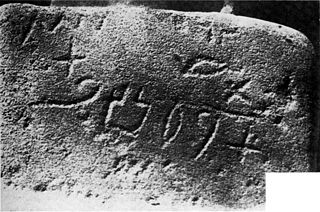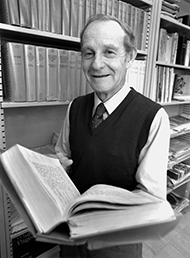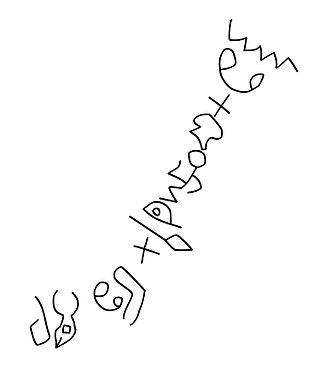Related Research Articles
The Book of Lamentations is a collection of poetic laments for the destruction of Jerusalem in 586 BCE. In the Hebrew Bible it appears in the Ketuvim ("Writings") as one of the Five Megillot alongside the Song of Songs, Book of Ruth, Ecclesiastes and the Book of Esther although there is no set order. In the Christian Old Testament it follows the Book of Jeremiah, as the prophet Jeremiah is its traditional author. However, according to modern scholarship, while the destruction of Jerusalem by Babylon in 586/7 BCE forms the background to the poems, they were most likely not written by Jeremiah. What has been instead proposed is that each of the book's chapters was written by a different anonymous poet, which were then joined to form the book.
Ugaritic is an extinct Northwest Semitic language, classified by some as a dialect of the Amorite language. It is known through the Ugaritic texts discovered by French archaeologists in 1929 at Ugarit, including several major literary texts, notably the Baal cycle. It has been used by scholars of the Hebrew Bible to clarify Biblical Hebrew texts and has revealed ways in which the cultures of ancient Israel and Judah found parallels in the neighboring cultures.

Proto-Sinaitic is found in a small corpus of c. 40 inscriptions and fragments, the vast majority from Serabit el-Khadim in the Sinai Peninsula, dating to the Middle Bronze Age. They are considered the earliest trace of alphabetic writing and the common ancestor of both the Ancient South Arabian script and the Phoenician alphabet, which led to many modern alphabets including the Greek alphabet. According to common theory, Canaanites or Hyksos who spoke a Canaanite language repurposed Egyptian hieroglyphs to construct a different script.
The history of the alphabet goes back to the consonantal writing system used for Semitic languages in the Levant in the 2nd millennium BCE. Most or nearly all alphabetic scripts used throughout the world today ultimately go back to this Semitic proto-alphabet. Its first origins can be traced back to a Proto-Sinaitic script developed in Ancient Egypt to represent the language of Semitic-speaking workers and slaves in Egypt. Unskilled in the complex hieroglyphic system used to write the Egyptian language, which required a large number of pictograms, they selected a small number of those commonly seen in their Egyptian surroundings to describe the sounds, as opposed to the semantic values, of their own Canaanite language. This script was partly influenced by the older Egyptian hieratic, a cursive script related to Egyptian hieroglyphs. The Semitic alphabet became the ancestor of multiple writing systems across the Middle East, Europe, northern Africa, and Pakistan, mainly through Ancient South Arabian, Phoenician, Paleo-Hebrew and later Aramaic, four closely related members of the Semitic family of scripts that were in use during the early first millennium BCE.
Cyrus Herzl Gordon was an American scholar of Near Eastern cultures and ancient languages.

David Noel Freedman was an American biblical scholar, author, editor, archaeologist, and, after his conversion from Judaism, a Presbyterian minister. He was one of the first Americans to work on the Dead Sea Scrolls. He is the son of the writer David Freedman. He died of a heart ailment.
Northwest Semitic is a division of the Semitic languages comprising the indigenous languages of the Levant. It emerged from Proto-Semitic in the Early Bronze Age. It is first attested in proper names identified as Amorite in the Middle Bronze Age. The oldest coherent texts are in Ugaritic, dating to the Late Bronze Age, which by the time of the Bronze Age collapse are joined by Old Aramaic, and by the Iron Age by Sutean and the Canaanite languages.
James Barr was a Scottish Old Testament scholar, known for his critique of the notion that the vocabulary and structure of the Hebrew language may reflect a particular theological mindset. At the University of Oxford, he was the Oriel Professor of the Interpretation of Holy Scripture from 1976 to 1978, and the Regius Professor of Hebrew from 1978 to 1989.
Jimmy Jack McBee Roberts, known as J. J. M. Roberts, is William Henry Green Professor of Old Testament Literature (Emeritus) at Princeton Theological Seminary in Princeton, New Jersey. A member of the Churches of Christ, Roberts attended Abilene Christian University before pursuing doctoral work at Harvard University.

Frank Moore Cross Jr. (1921–2012) was the Hancock Professor of Hebrew and Other Oriental Languages Emeritus at Harvard University, notable for his work in the interpretation of the Dead Sea Scrolls, his 1973 magnum opusCanaanite Myth and Hebrew Epic, and his work in Northwest Semitic epigraphy. Many of his essays on the latter topic have since been collected in Leaves from an Epigrapher's Notebook.
Mark Stratton John Matthew Smith is an American biblical scholar, anthropologist, and professor.

The Wadi el-Hol inscriptions are two rock inscriptions which appear to show the oldest examples of phonetic alphabetic writing discovered to date.

Prof. Christopher A. Rollston is a scholar of the ancient Near East, specializing in Hebrew Bible, Greek New Testament, Old Testament Apocrypha, Northwest Semitic literature, epigraphy and paleography.
Choon-Leong Seow, known as C. L. Seow, is a distinguished biblical scholar, semitist, epigrapher, and historian of Near Eastern religion, currently as Vanderbilt, Buffington, Cupples Chair in Divinity and Distinguished Professor of Hebrew Bible at Vanderbilt University. An expert in wisdom literature, Seow has written widely in the field of biblical studies.
Michael Patrick O'Connor was an American scholar of the Ancient Near East and a poet. With the field of ANE studies he was a linguist of Semitic languages, with a focus on biblical Hebrew and biblical poetry.
Richard Samuel Hess is an American Old Testament scholar. He is Earl S. Kalland Professor of Old Testament and Semitic Languages at Denver Seminary.
Jo Ann Hackett is an American scholar of the Hebrew Bible and of Biblical Hebrew and other ancient Northwest Semitic languages such as Phoenician, Punic, and Aramaic.
Katharine Doob Sakenfeld is an American Old Testament scholar. She is Professor of Old Testament Literature and Exegesis Emerita at Princeton Theological Seminary, having previously been William Albright Eisenberger Professor of Old Testament Literature and Exegesis.
Patrick William Skehan was an American Old Testament semitic scholar.
P.Bodl. MS bibl. Gr. 5 is a septuagint manuscript of the biblical book of Psalms. The manuscript has been dated to the second century CE, or even later.
References
- ↑ "Dobbs-Allsopp CV" (PDF). Princeton Theological Seminary. Archived from the original (PDF) on March 4, 2016. Retrieved July 4, 2015.
- ↑ "Photographs of Wadi el-Hol Survey". West Semitic Research Project. Archived from the original on July 23, 2015. Retrieved July 4, 2015.
- ↑ "The Probable Inventors of the First Alphabet, by Christopher Rollston". Rollston Epigraphy. Retrieved July 4, 2015.
- ↑ "The Great Authenticator". Johns Hopkins Magazine. Retrieved July 22, 2015.
- ↑ "Alphabet's History Rewritten By Finding". Johns Hopkins Gazette. Retrieved July 4, 2015.
- ↑ "Discovery of Egyptian Inscriptions Indicates an Earlier Date for Origin of the Alphabet". New York Times. Retrieved July 22, 2015.
- ↑ "Volume Overview". Yale University Press. Retrieved July 4, 2015.
- ↑ Dobbs-Allsopp, F. W. (2015). Early Praise for On Biblical Poetry. Oxford University Press. ISBN 978-0-19-976690-1 . Retrieved July 22, 2015.
- ↑ "Hebrew Poetry". Oxford Bibliographies. Retrieved July 22, 2015.
- ↑ "List of Participants for Oxford Hebrew Bible". The Hebrew Bible: A Critical Edition. Retrieved July 5, 2014.
- ↑ "Dobbs-Allsopp CV" (PDF). Princeton Theological Seminary. Archived from the original (PDF) on March 4, 2016. Retrieved July 4, 2015.